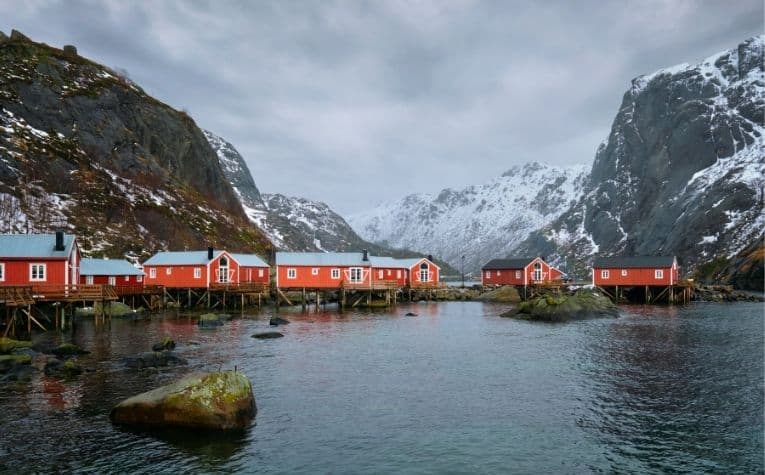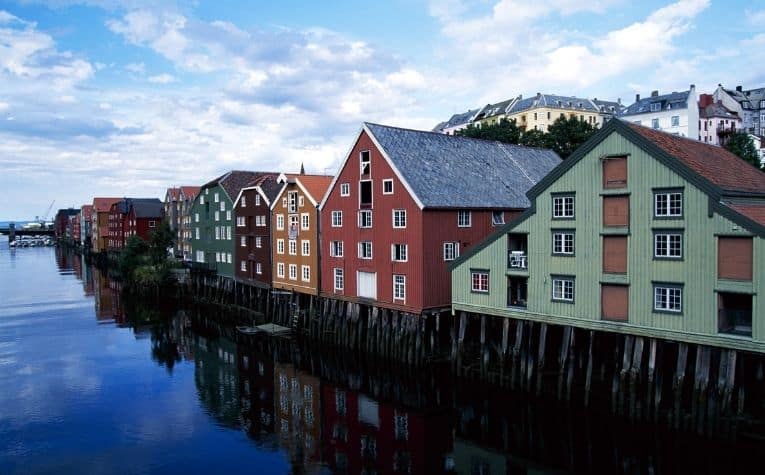Many visitors to Norway, or people who see pictures of the Scandinavian country online or on television, notice something interesting about the houses: a lot of them are painted red. But why?
Norway has a lot of red houses because of social traditions that date back centuries.
Red used to signify the upper class in Scandinavian countries like Norway, making it a color associated with success.
Like elsewhere in the world, a trend in one generation can become a custom in the next one.
Why exactly was red the color of success? What are some other possibilities why so many Norwegians have red houses? Keep reading to learn more.
Norway has a fascinating history. See Norway in World War 2: Interesting Facts to learn more.

Red homes and social status
In earlier eras, red reflected wealth, and therefore, a high social standing in Scandinavia.
In other places around the world, it could be a different color, but in Northern Europe, including Sweden and Denmark, red marked the elite families in the population and set them apart from commoners.
Red houses don’t necessarily suggest that current residents are wealthy or that they belong to a high social class in the country.
Wealth in Norway may be reflected in the size of a family’s house or where it is located, but the color of the home most likely represents the personal tastes of the homeowners more than anything else.
Red homes today in Norway are mostly the product of tradition or one of the other factors mentioned below.
As stated above, trends in one era can become customs in the next one, even though the reasons are different.

Red houses resemble redbrick buildings
Still today the term “redbrick” has connotations of prestige and status.
Such places don’t belong exclusively to higher classes of people at present, but a common term used to describe them, redbrick, comes from a time in which they did.
For example, elsewhere in Europe, a “redbrick university” is often indicative of an institution of higher learning that is historically reputable and conventionally coveted.
Both Oxford and Cambridge in the United Kingdom, for instance, are considered “redbrick” universities.
While the use of red brick in building construction is still seen as a sign of wealth and privilege in some regions, it was even more so in 16th-century Europe.
Red brick, in essence, was a sign to others that the residents of that house were important people.
During a time when class divisions were prominent, especially in the Western world, projecting a high social status was important. Owning a building clad in this material was one of many ways to display such status.
It was vital to display wealth though dialect, fashion, interests, lifestyle choices, hobbies, and, of course, the appearance of one’s home.
Do Norwegians and Danes dislike each other? See Why Do Norwegians Hate Swedes and Danes to learn more.

Swedish nobles sought alternatives to red bricks
Legend has it that in the 16th-century, Swedish nobles hoped that painting their houses red would provide a less expensive substitute for expensive red bricks.
If the homeowners couldn’t have the actual expensive building product, perhaps they could have the appearance of it
Taking advantage of the plethora of copper mines in the region, the Swedes created red paint at minimal cost and quickly shipped it out to surrounding countries, Norway included.
The Norwegian upper class soon adopted the practice before those among the lower social classes copied it.
During the Industrial Revolution in the Western World, importing Swedish red paint became a large national export. Soon, the substance was so affordable humble farmers and struggling families used it as well.
Red paint is affordable today
In modern times, the availability and affordability of red paint is a practical reason why the colorful tradition continues today.
Paint made from iron oxide was, and still is, readily available in Scandinavia.
However, it’s no longer the status symbol it was originally considered and is now a staple of rustic, hardworking households.
Norway and Sweden have similarities and differences. See Are Norwegians and Swedes the Same People? to learn more.

Another option: red is the main color on Norway’s flag
The Norwegian flag is mostly red, so it is a color found throughout the country, such as on patriotic clothing and on sports uniforms.
The nation’s striking red houses may be a cultural link to the national flag.
Pride regarding one’s country is an important part of Norwegian culture, and the civilians’ houses could be a nod to the national colors.
That said, most experts agree that the appearance of the houses was more influenced by societal and economic factors rather than a bold display of patriotism.
Why Are Some Houses Painted in Other Colors?
The answer to this question is partially subjective, but some people believe that owners of non-red houses seek to differentiate themselves from others.
Monotony is why some people opt to paint their houses in other primary colors such as yellow and white.
Some houses were even painted as a red and white hybrid. Because white paint was more expensive in centuries past, only partially cladding homes in red saved people money.
The Tradition Still Lives On
The struggle for status was a central part of life in the Early Modern period in Northern Europe.
If only those sixteenth-century aristocrats could have seen what red paint later came to symbolize.
As international trading and mass production became prominent two centuries later, red-painted homes became a defining trademark of honest, workman-like households.
The copper mines provided an invaluable source of income to residents, and they used these abundant minerals to clad their houses against the brutal elements of the perpetual Scandinavian winters.
The tradition is still seen in Norway, Sweden, and Denmark today. As some generational traditions are refined, improved, or left behind entirely, others continue to get passed down family trees.
Red houses are one of them. They will most likely always remain a symbol of Nordic homes.
While the actual paint may improve and become cheaper and offer greater protection against the climate, the striking colors will light up the nation’s rolling hills and deep valleys for centuries to come.
Sometimes it can be confusing for non-Scandinavians to identify the various residents of the region. See Are Norwegians and Swedes the Same People? to learn more.

Beautiful Norwegian homes
Norwegian homes are beautiful and many non-Norwegians enjoy looking at them next to blue waterways and green hills and pastures.
Perhaps people like them because of their aesthetic appeal or because they are trying to imagine what it would be like to live in Norway themselves.
Like customs elsewhere in the world, the reason these homes were once painted red isn’t the reason they are still coated in red today.
Yet many of the people who live in them today are descendants of those who started the tradition and mimicking them to some degree connects the eras.
